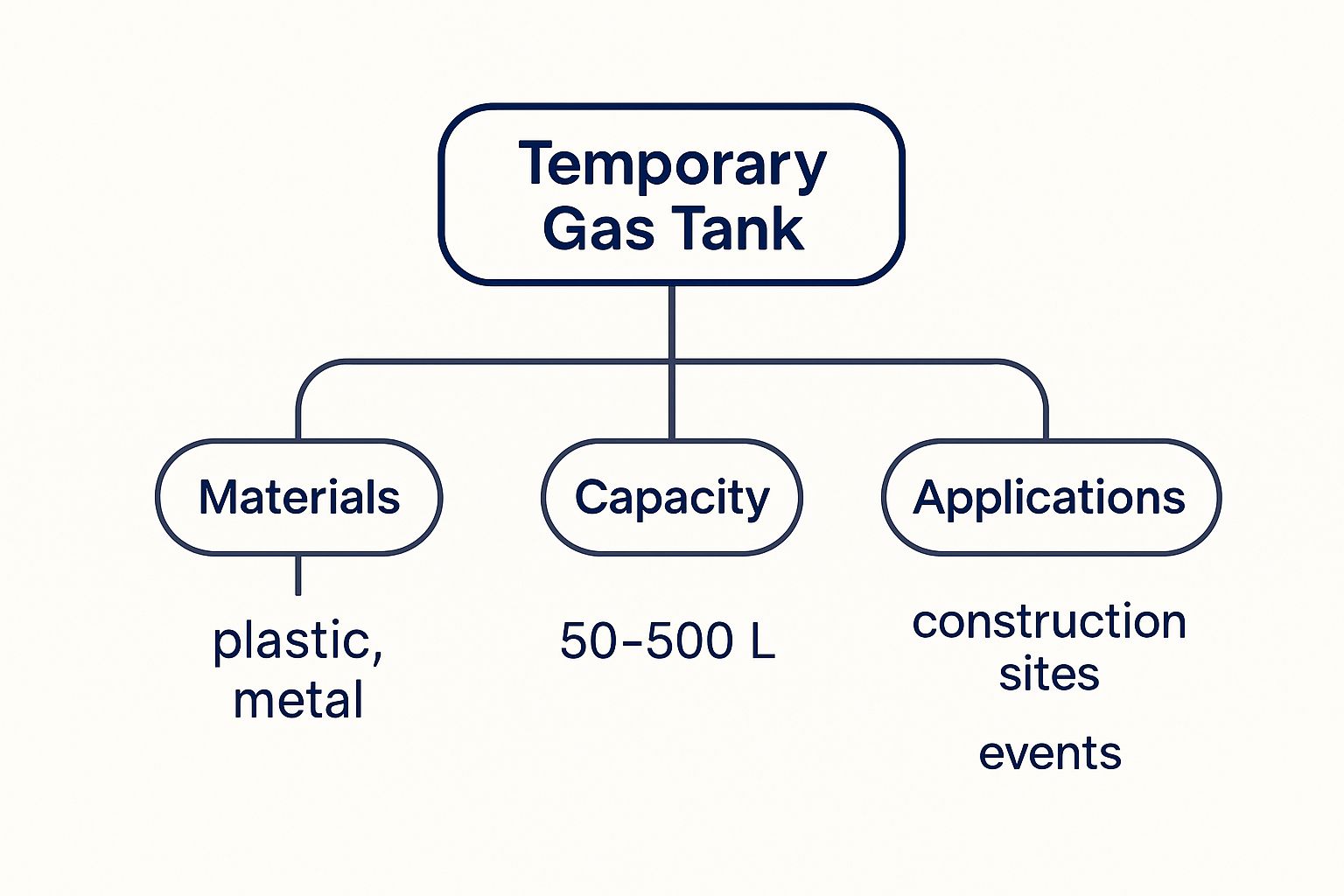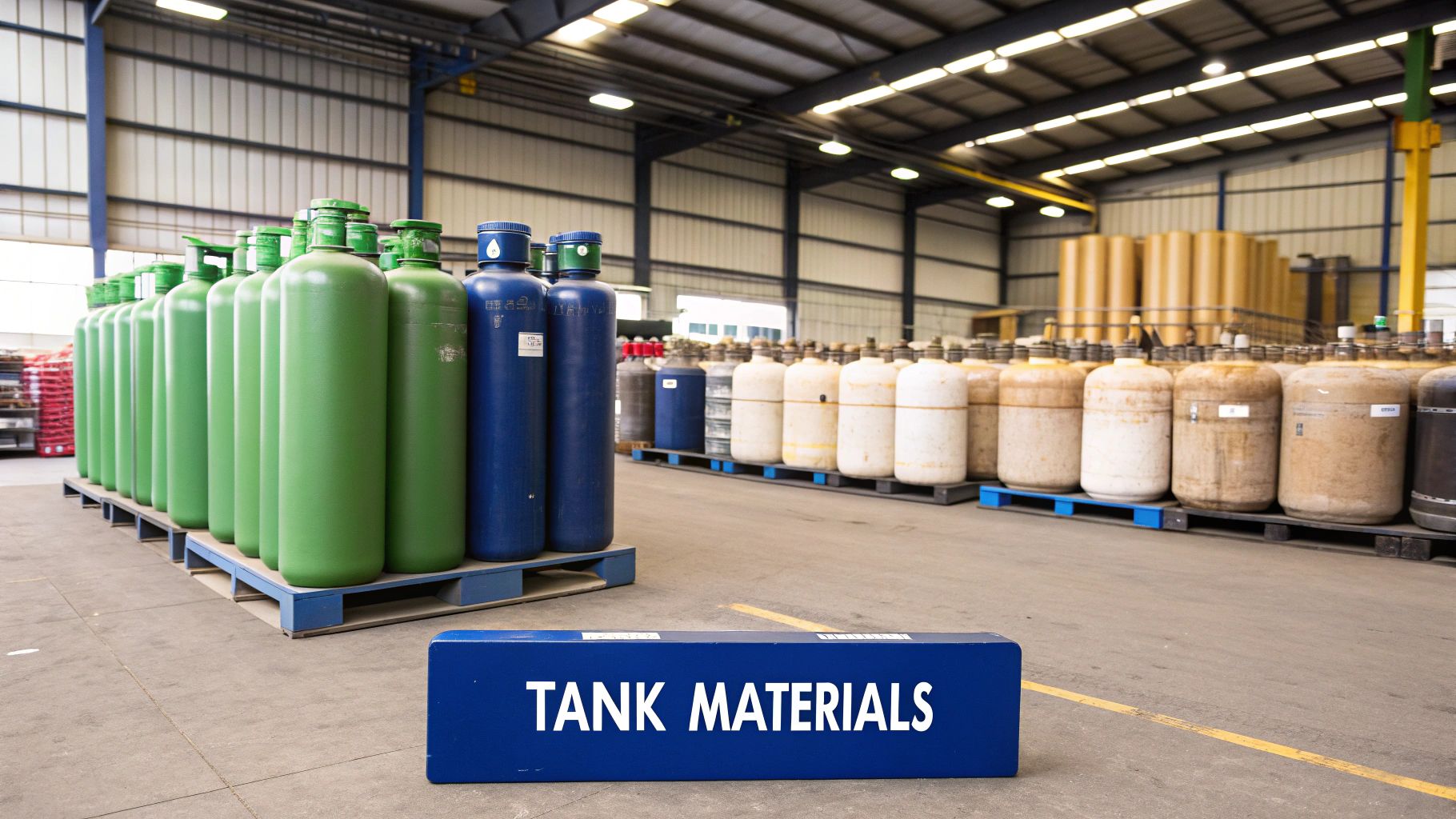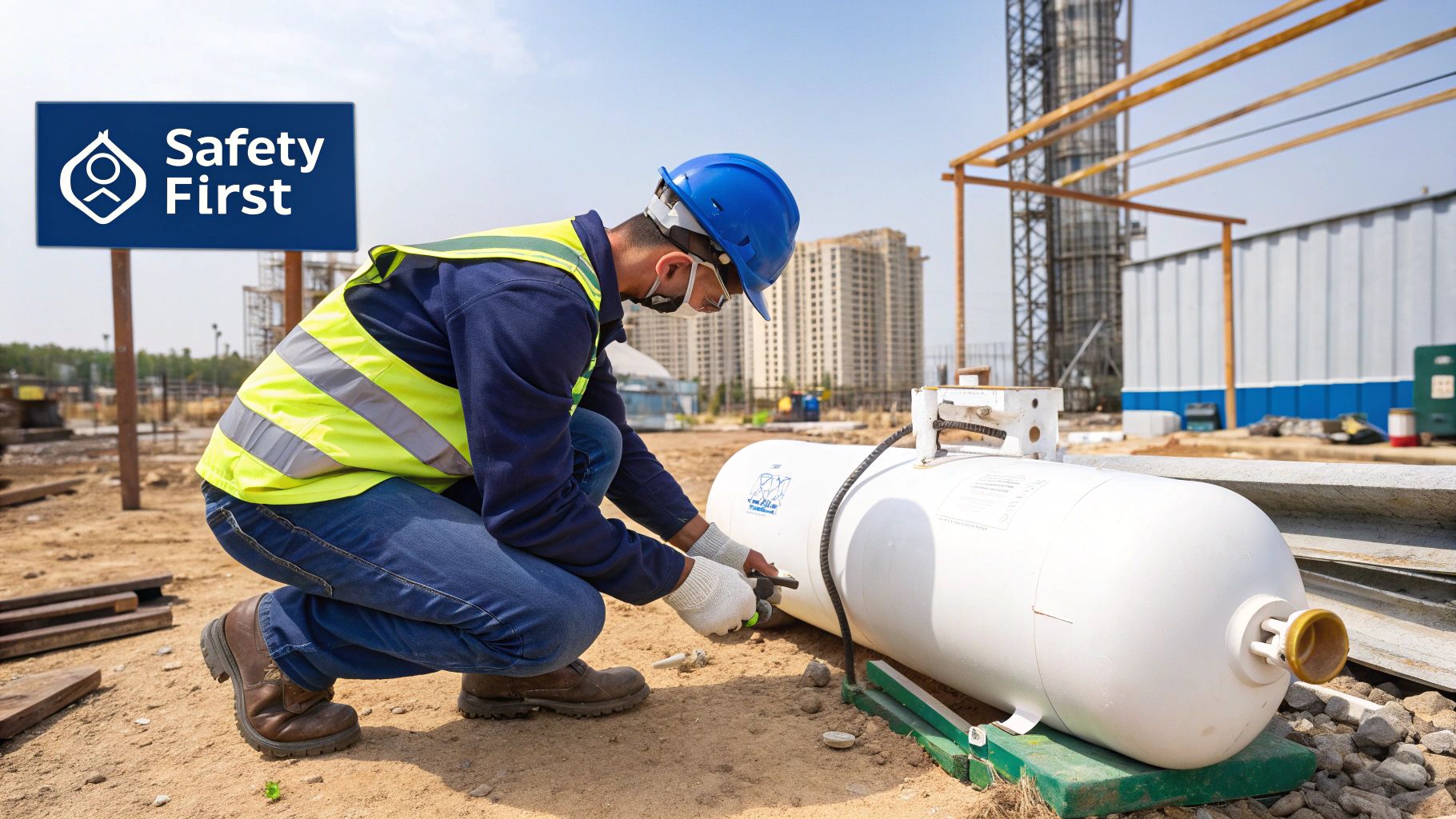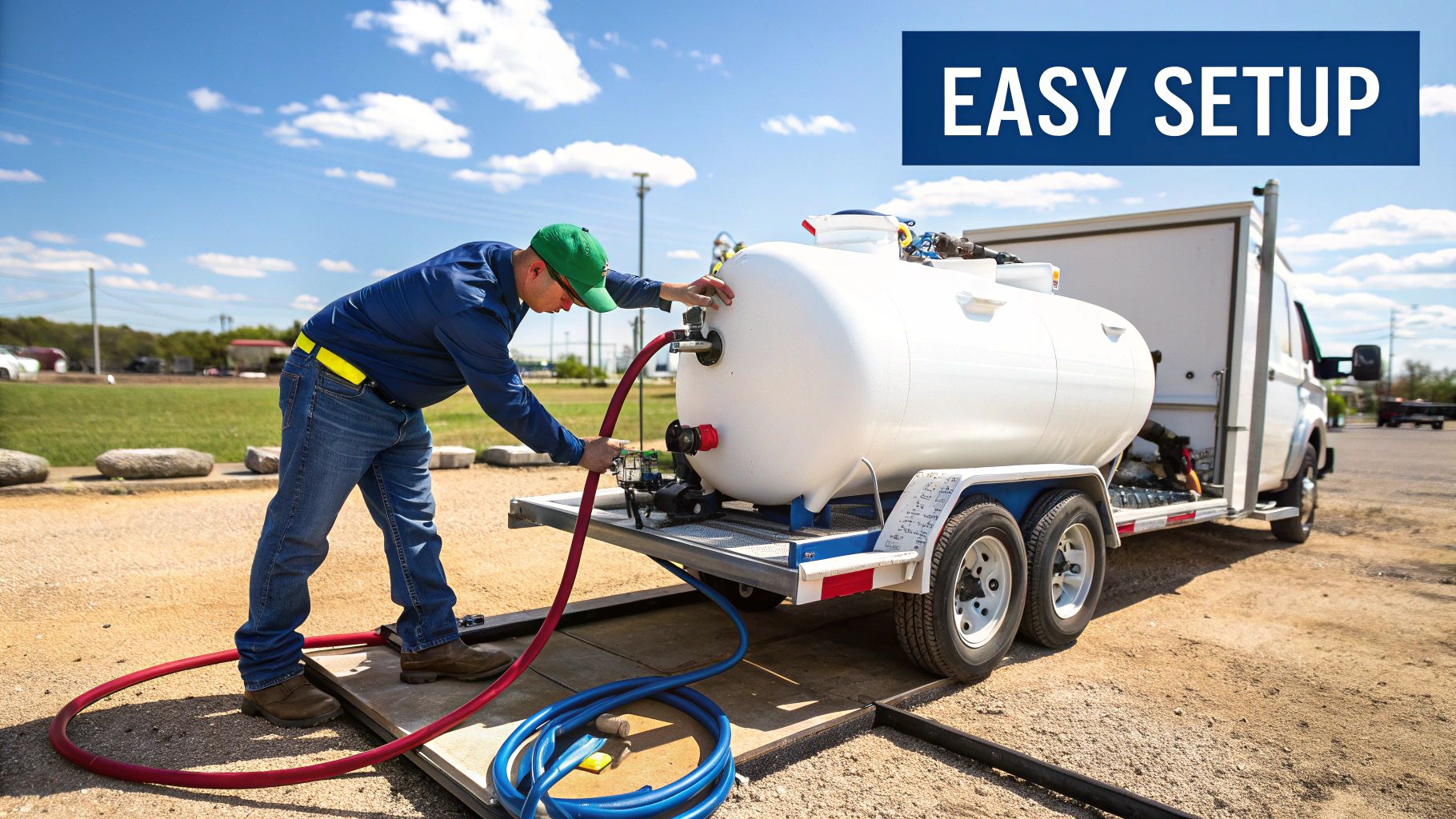A temporary gas tank for a boat is a portable, specialized fuel container designed to safely store gasoline and feed it directly to an outboard motor. It’s far more than just a plastic jug; it’s a self-contained fuel system built specifically for the demanding marine environment.
What Exactly Is a Temporary Boat Gas Tank?
It’s best to think of a temporary gas tank as a purpose-built reserve tank for your boat, not just a beefed-up jerry can. There's a world of difference. A standard gas can from the hardware store is only meant to transport fuel from the pump to a vehicle. A marine-grade temporary tank, on the other hand, becomes an active part of your boat's fuel system.
This distinction is all about safety and engine performance. These tanks are engineered to handle constant sun exposure, the vibrations of a moving boat, and the corrosive salt and spray you'll inevitably encounter on the water. A regular can simply isn't built for that and lacks the proper connectors, venting systems, and rugged construction needed for a marine setting.
This infographic breaks down the core concepts, from the materials used to how they're commonly put to work.

As you can see, these tanks are versatile tools. Their construction and capacity really determine where they fit best. This growing need for reliable portable fuel is also showing up in the numbers. The portable fuel tank market was valued at a healthy $1.2 billion USD in 2023 and is expected to reach $2.1 billion USD by 2032. You can discover more insights about this growing market trend and what's behind the growth.
To really get why these tanks are so different, it helps to compare them side-by-side with the familiar red plastic can you have in your garage.
Key Differences Between a Standard Gas Can and a Marine Temporary Gas Tank
| Feature | Standard Gas Can | Marine Temporary Gas Tank |
|---|---|---|
| Primary Use | Short-term transport of fuel | Active fuel supply for an engine |
| Construction | Basic polyethylene | UV-resistant, high-density polyethylene |
| Venting | Simple spout or basic vent | Manual screw vent for pressure equalization |
| Fuel Connector | None; designed for pouring | Engine-specific quick-disconnect fitting |
| Durability | Not built for constant vibration or sun | Engineered for marine stress and exposure |
| Safety Features | Basic spill-proof nozzle | Leak-proof connectors, stable design |
This table makes it clear: using a standard can on your boat isn't just inconvenient, it's a genuine safety risk.
Essential Components of a Marine Tank
To appreciate the design, let's look at the key parts that make a temporary gas tank a dependable fuel source out on the water. Each piece has a specific job to do, ensuring fuel gets from the tank to your engine safely and consistently.
- Reinforced Tank Body: This is the shell, usually made from a thick, UV-resistant plastic like polyethylene. It's built tough to prevent fuel vapors from seeping out and to handle the bumps and sun that come with boating.
- Fuel Line Connector: This isn't just a simple opening. It's a specialized, quick-disconnect fitting designed to match your specific brand of outboard motor (like Yamaha, Mercury, or Honda). This ensures a secure, leak-free connection every time.
- Safety Vent: You'll find a small screw on the cap that you need to open before running the engine. This vent allows air to enter the tank as fuel is used up, preventing a vacuum from forming that could starve your engine of fuel.
- Integrated Fuel Gauge: Many tanks come with a simple mechanical gauge right on the cap. It gives you a quick, at-a-glance estimate of how much fuel you have left.
Understanding these parts is the first step toward safe and effective use. It’s not just about carrying extra fuel; it’s about having a system you can depend on when you're miles from shore.
Ultimately, a temporary gas tank offers flexibility and peace of mind. Whether it's the main fuel supply for a small fishing boat or a critical backup for a larger vessel on a long trip, its specialized design is a non-negotiable part of safe boating.
When a Portable Fuel Tank Becomes Essential

So, let's get practical. When does a portable fuel tank go from being a nice-to-have accessory to something you absolutely can't leave the dock without? For a lot of us, it’s not even a question—it's a core piece of our setup. Think of it as your safety net, range extender, and a trusty diagnostic tool all rolled into one.
For smaller boats—like your dinghy, jon boat, or a sailboat with a little kicker motor—the temporary gas tank is often the main, and only, fuel source. Its portability is everything. You can easily unhook it, haul it to the gas station, and secure it back in the boat for your next trip. This simple setup keeps the boat's design clean, saving precious space and weight where every inch and every pound makes a difference.
Extending Your Adventures and Peace of Mind
Even on larger boats with built-in tanks, a portable tank is the ultimate backup plan. Picture this: you're exploring a new stretch of coastline, pushing a little farther from your home port than you normally would. Having an extra 6 or 12 gallons of fuel stashed away can turn a stressful, fuel-gauge-watching trip back into a relaxed cruise.
This extra fuel isn't just for "what if" scenarios, either. It gives you real strategic advantages on longer journeys:
- Exploring Remote Areas: It’s your ticket to those far-off fishing spots or secluded coves, freeing you from the tyranny of the fuel dock.
- Fueling Auxiliary Gear: You can run a small generator or a dinghy tender from a dedicated portable tank, keeping its fuel supply separate from your main engine's.
- Weather Delays: If a squall keeps you anchored longer than expected, that reserve fuel lets you run the generator for power without dipping into what you need to get home.
This reliance on portable fuel for boating and other outdoor activities is a big deal. The global market for butane fuel tanks, a key part of the portable fuel world, was valued at roughly $1.5 billion USD in 2025. And it’s only expected to grow, thanks to more people getting outdoors. You can dig into the specifics of butane fuel tank market trends if you're curious.
A Critical Tool for Diagnostics and Maintenance
Here’s where a temporary gas tank really proves its worth for any boater. It's one of the best troubleshooting tools you can own. If you think you've got bad fuel—water or gunk—in your main tank, you can bypass it completely. Just hook your engine up to a small, clean portable tank with fresh gas. In minutes, you'll know for sure if the problem is your boat's fuel system or something else.
Think about it: You just paid to have your outboard serviced. Before you run it on the fuel that's been sitting in your main tank all winter, you can do a quick test run with a small temporary tank filled with fresh, clean fuel. This confirms the engine is running perfectly and prevents old fuel from causing new problems.
In these moments, a simple portable tank can be the difference between a frustrating day on the water and a dangerous one. That makes it one of the most versatile and essential pieces of safety gear you can have on board.
How to Choose the Right Temporary Gas Tank

Picking out a temporary gas tank might seem simple, but there's more to it than just grabbing the first one you see. This decision is a big deal for your boat's safety and performance, not to mention staying on the right side of environmental rules. Don't think of it as just a can for gas—it's a critical part of your boat's fuel system.
Making the right call means you'll have a steady, reliable fuel supply without worrying about leaks or whether the tank can handle the rough marine environment. A poor choice, on the other hand, can lead to anything from engine stalls and fuel spills to a serious fire risk. Let’s walk through what you need to look for to get the perfect tank for your boat.
Material Matters: Plastic vs. Metal
The first decision you’ll need to make is about the material. The vast majority of portable tanks you'll find today are made from a tough, UV-resistant polyethylene plastic, and there are some solid reasons why. Plastic tanks are light, incredibly durable, and they won't rust or corrode, even in saltwater. They also tend to bounce back from minor impacts instead of denting.
Of course, metal tanks (usually steel) are still around. They're built like, well, a tank. But they’re also much heavier, can rust if you don’t keep an eye on them, and often cost more. For most of us out on the water for fun, a quality plastic temporary gas tank is the way to go, hitting that sweet spot of performance, durability, and cost.
Sizing Your Tank for Your Needs
Next up is capacity. How big of a tank do you actually need? Portable marine tanks typically come in 3-gallon, 6-gallon, and 12-gallon sizes. The trick isn't to buy the biggest one possible, but to match the tank size to your boat and how you use it.
- 3-Gallon Tanks: These are perfect for small inflatables, dinghies with little kicker motors, or even as a small, separate tank for testing your engine.
- 6-Gallon Tanks: This is the crowd favorite. It offers a great mix of range and manageability for most small-to-midsize fishing boats and sailboats.
- 12-Gallon Tanks: If you're planning longer trips or running an older, thirstier two-stroke engine, this size gives you a much-needed range boost or a serious backup fuel supply.
A good rule of thumb is to figure out your engine's fuel consumption (gallons per hour) and think about how long you're usually out on the water. Whatever you calculate, always bring more fuel than you think you'll need. It's the oldest rule in boating for a reason.
Understanding Compliance: EPA and CARB
Last but certainly not least, you have to think about safety and environmental rules. This part isn’t optional. Always look for tanks that are compliant with regulations from the Environmental Protection Agency (EPA) and the California Air Resources Board (CARB). These standards exist to keep you, and the waters we all enjoy, safe.
A compliant temporary gas tank isn't just a sticker on the side. It means it has features like low-permeation walls that prevent gas vapors from escaping and automatic vents that safely manage pressure changes without you having to touch a thing. These are vital safety features that prevent dangerous fume buildup and messy spills.
For a closer look at some of the top-rated, compliant tanks on the market, check out our guide to the best portable marine fuel tank picks for 2025. Choosing a certified tank is your guarantee that you’re getting a product designed and built for safety and reliability.
Mastering Safe Fuel Handling and Storage

Let's be blunt: handling gasoline on a boat demands your complete attention. A temporary gas tank is an incredibly useful tool, but it's only as safe as the person using it. The rules we're about to cover aren't just suggestions; they're the absolute bedrock of preventing fires, spills, and dangerous fume buildup.
Think of it like a pilot's pre-flight checklist. It's a simple, consistent routine that ensures every trip starts safely. These small habits are what separate a prepared boater from a potential accident waiting to happen.
The Golden Rule of Refueling
If you remember only one thing, make it this: always fill your portable tank on land, never on the boat. It’s a non-negotiable.
Pull the tank right out of your vessel and set it on a flat, stable surface—the dock, the pavement at the gas station, wherever. This single step virtually eliminates the risk of a static spark igniting gas vapors, which is a very real danger.
Filling on land also contains any accidental spills. A few drops of fuel on the ground is a minor mess. In your boat, those same few drops can create an explosive vapor cloud in the bilge. We have a detailed guide that explains exactly where portable gasoline fuel tanks should be filled if you want to dig deeper.
Pro Tip: Never fill a tank to the absolute brim. Gasoline needs room to expand as it heats up. Leaving about 5% of the tank empty gives it that space and stops fuel from being forced out of the vent on a hot day.
Understanding your gear is a huge part of staying safe. While the context is different, learning about things like LPG cylinder regulators and safety devices reinforces the core principles of pressure management and safety shut-offs that apply to any fuel system.
Your Onboard Safety Checklist
Once your tank is filled, getting it safely secured onboard is the next critical task. A loose tank sliding around is a major hazard.
Here's what to check every single time:
- Secure It Down: Place the tank in a dedicated spot where you can strap it down firmly. If you can keep it out of direct sunlight, even better—that helps minimize heat expansion.
- Let It Breathe: Ventilation is key. The storage area must have good airflow to carry away any potential fumes. Never, ever store a gas tank in an enclosed cabin or a sealed compartment.
- Give It a Sniff: Before you head out, do a quick visual and sniff test. Check the tank, fuel line, and all the connectors for cracks, wet spots, or the smell of gas.
- Check the Connection: Make sure the fuel line connector clicks firmly into place on both the tank and the engine. A loose connection is one of the most common causes of leaks and engine trouble.
Seasonal Storage Checklist for Your Temporary Gas Tank
When the boating season winds down, don't just toss your tank in the shed. Properly preparing it for storage protects the tank, ensures your safety, and makes getting back on the water next season a whole lot easier.
| Step | Action Required | Reason |
|---|---|---|
| 1. Stabilize or Empty | Add a quality fuel stabilizer to the gasoline if storing for more than 30 days. Alternatively, safely empty the tank into your car or a proper disposal container. | Prevents fuel from degrading, gumming up, and damaging your engine. An empty tank eliminates fume buildup during storage. |
| 2. Clean the Exterior | Wipe down the outside of the tank with a damp cloth to remove any dirt, salt, or grime. | Prevents corrosion and keeps the tank in good condition. |
| 3. Check for Damage | Inspect the tank, hose, and connectors for any cracks, leaks, or wear and tear. | It’s better to find and fix problems now than to discover them on your first trip next season. |
| 4. Store Properly | Keep the tank in a well-ventilated area like a garage or shed, away from direct sunlight, heat sources, or open flames. | Reduces the risk of fume accumulation and fire hazards. |
| 5. Disconnect | Ensure the fuel line is disconnected from both the tank and the engine. | Prevents accidental leaks and pressure buildup in the line during storage. |
Following these steps ensures that when the weather warms up, your fuel tank will be in perfect shape and ready to go.
Keeping Your Tank in Top Condition
Think of your temporary gas tank as more than just a plastic container. It’s a critical piece of your boat's fuel system, and giving it a little attention goes a long way in protecting your engine and your time on the water. If you neglect it, you're setting yourself up for frustrating engine troubles that can ruin a perfectly good day.
The great news? Keeping your tank in prime shape is surprisingly easy. You don't need to be a master mechanic; a simple, consistent routine is all it takes to head off the most common fuel-related headaches. It all boils down to three things: regular inspections, proper cleaning, and smart fuel management.
Regular Inspection Checklist
Before you head out, take a minute to give your fuel system a quick once-over. This simple habit can help you spot small problems before they leave you stranded. Your main focus should be the fuel line and the primer bulb—these are usually the first parts to show their age.
Here’s a quick checklist of what to look for:
- Cracks and Stiffness: Give the primer bulb a good squeeze and bend the fuel line a bit. It should feel flexible and soft, not stiff or brittle. If you see any cracks, even tiny ones, it's time to replace the part. Don't wait.
- Secure Connections: Jiggle the connectors where the line meets the tank and the engine. They should snap into place firmly and feel snug. A loose connection can starve your engine of fuel or, worse, create a dangerous leak.
Your fuel line and primer bulb are like the arteries of your fuel system. A clog or a leak here is just as bad as an empty tank. A quick check is your best insurance against a long paddle back to shore.
Cleaning and Fuel Stabilization
Over time, it's inevitable that a little water from condensation and some random debris will end up in your tank. This gunk is a primary culprit behind poor engine performance. For a really thorough breakdown on this, check out our expert guide for marine fuel tank cleaning.
When it comes to the fuel itself, especially if the boat's going to sit for a while, a good fuel stabilizer is non-negotiable. Today's ethanol-blended gas can start breaking down in as little as 30 days. This process creates sticky gums and varnish that will clog up your carburetor and fuel injectors in a hurry.
Adding a stabilizer is simple—just follow the directions on the bottle. It keeps the fuel fresh, ensuring your engine fires right up and runs like a top, even after a long winter in storage. Of course, keeping the rest of your vessel in great shape is just as important; you can find some great recommendations on the best boat cleaning products to protect your investment from top to bottom.
Got Questions About Portable Gas Tanks? We've Got Answers.
Even after you get the hang of using a portable gas tank, a few practical questions always seem to come up. This section is your go-to guide for those common "what ifs" and "how tos" that every boater thinks about. We want to clear up any confusion so you can head out on the water without a second thought.
Think of this as the kind of chat you'd have with a seasoned boater down at the marina. We'll cover everything from figuring out your trip range to what to do with your tank when the season ends. By the time you're done reading, you'll handle your portable tank like you've been doing it for years.
How Far Can I Go On A 6-Gallon Tank?
That's the million-dollar question, isn't it? The honest answer is: it completely depends on your boat. Your range all comes down to your boat's fuel efficiency, or its miles per gallon (MPG). That number can swing wildly based on your engine, the boat's weight, how fast you're going, and even if you're battling wind and waves.
Just to give you a ballpark, a small, efficient outboard might get 5-10 MPG. On a 6-gallon tank, you're looking at a range of about 30-60 miles. But if you've got an older, thirstier motor, you might only get 2-3 MPG, which cuts your range down to a much smaller 12-18 miles.
The only way to know for sure is to figure out your own boat's burn rate. Here’s a simple way to do it:
- Fill your portable tank all the way to the top.
- Go for a typical run—the speed and distance you'd normally travel.
- When you get back, carefully measure exactly how much fuel it takes to fill the tank back up.
Doing this little test gives you a real, reliable number to work with. It takes all the guesswork out of planning your trips and makes sure you've always got enough gas to get home safely.
Can I Just Use A Regular Red Gas Can From The Garage?
I'm glad you asked, because the answer is a hard no. Using a standard automotive gas can for your boat is a terrible idea and a serious safety hazard. They simply aren't built for the marine world, and there are a few huge differences you need to know about.
Marine-specific portable tanks are made from special plastics that won't break down under constant sun exposure and are designed to stop fuel vapors from seeping out. Crucially, they have the right sealed fittings for a marine fuel line and a proper vent system to handle pressure changes as the temperature fluctuates.
Using a car gas can is more than just unsafe—it can contaminate your fuel, damage your engine, and might even get you in trouble with the Coast Guard. Always, always use a tank that was actually made for a boat.
Should The Vent Be Open While The Engine Is Running?
Yes, absolutely. For pretty much any standard portable tank you'll find, opening that little vent screw is a must. You need to open it before you start the engine and leave it open the entire time you're out on the water. It’s a vital part of how the whole system works.
As the engine sips fuel from the tank, the open vent allows air to get in and take its place. This keeps the pressure equalized and prevents a vacuum from forming. If you forget to open it, that vacuum will build until it overpowers the fuel pump, starving your engine of gas and causing it to stall—usually at the worst possible moment.
It never hurts to double-check the manual for your specific tank, as a few of the newest designs have self-venting features. But for the vast majority of tanks out there, the rule is simple: if the engine's running, the vent is open.
What’s The Best Way To Store My Tank For The Winter?
Storing your tank correctly during the off-season is the key to making it last and ensuring you have good, clean fuel ready for your first trip next spring. The first thing you'll want to do is add a good marine fuel stabilizer to the gasoline, following the instructions on the bottle for the right mix.
After you've treated the fuel, fill the tank up to about 95% full. This is a pro tip. Leaving only a tiny bit of air space at the top dramatically reduces the chance for condensation to form, which keeps water out of your fuel over the long winter months.
Finally, find a cool, dry, and well-ventilated spot for it, like a garage or a shed. Keep it far away from any ignition sources—things like furnaces, water heaters, or any kind of open flame. And for safety's sake, always store the tank off the boat, and never bring it inside your house.
Fueling up should be a simple part of your day, not a messy, stressful chore. With CLiX Fueling Solutions, you can forget about accidental spills and costly overfills. See how our spill-free system can make your boating life cleaner and safer at https://clixfueling.com.












